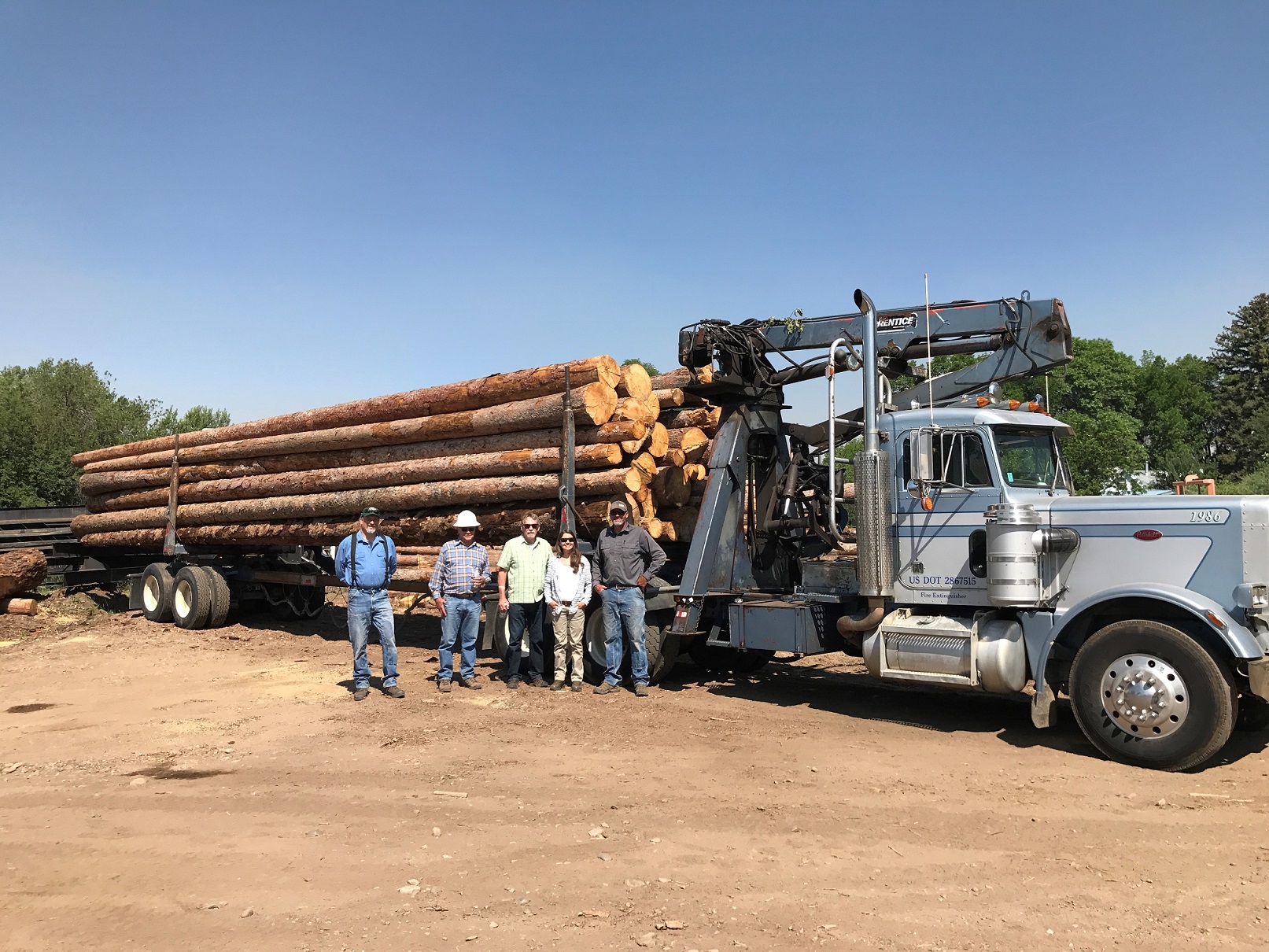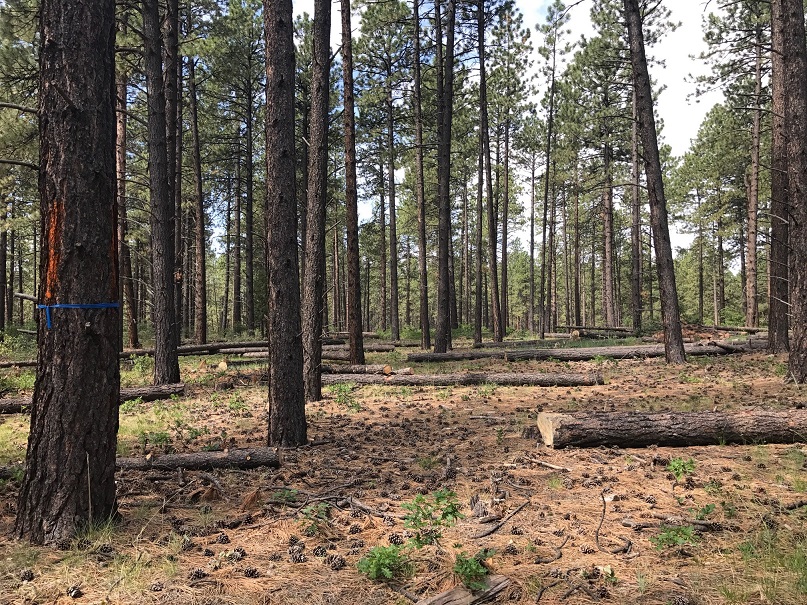Colorado Business Loan Fund: Collaboration Key to Investing in our Biomass Business Community

Site Visit to Wildcat Services, in Bayfield, Colorado. Left to right: Mark Loveall, Jeff Ollinger, Randy Johnson, Melissa Simmons of our Forest Business Loan Fund (not pictured are Andra Thaden & Tim Reader) standing with Andy McCoy (Wildcat Services).
A logger in southwestern Colorado approached me following a workshop I had just hosted on a unique lending partnership for our forest products and biomass business community. At the conclusion of our workshop the logger came up to me, shook my hand and said, “Tim, I’m not looking for a handout, but I wouldn’t mind a hand.” This simple statement best represents our unique lending partnership in southwestern Colorado including the Colorado State Forest Service (CSFS), the Upper Arkansas Area Council of Governments (UAACOG), members of our Community Biomass Enterprise Development Fellows Team, local based community lenders, and our biomass utilization business community.
This partnership is filling a niche in a high risk lending arena: forest products and biomass utilization businesses that can’t qualify for traditional forms or sources of financing. Our forest products and biomass utilization community often face challenges that have significant impacts to their profitability and ability to qualify for a business loans. Biomass supply and availability, availability of workforce, weather, globally competitive markets, and past financial performance often make traditional sources of lending unavailable to these businesses due to real and perceived risk associated with this business community. Often, traditional lenders have limited comfort levels in lending to businesses that they may have little to no knowledge about, and in the higher risk they may associate with lending to our forest products or biomass utilization business community. One lender in the San Luis Valley summed up his hesitancy by telling me the three types of businesses he would never loan to again, “sawmills, restaurants, and….did I say sawmills.” Clearly this demonstrates a need to provide an alternative to traditional forms of financing, or at the very least, one in partnership with traditional lenders; one that provides greater knowledge on our biomass business community and one that recognizes the increased risk associated with this business community. Our collaborative lending approach is taking the traditional lender-applicant relationship and opening it up to a positive collaboration of community based advocacy, one that is applicant centered, shares of both the risk and return. One of our businesses that was applying for financing from our program summed up his past business history in a simple statement. ”The bad news is that I have made every mistake in the business…the good news is that I have made every mistake in the business.” Ordinarily an admission like this leading off discussions on his worthiness to receive financing might lead to hesitancy on any lenders part but it was his complete transparency that helped build our lending relationship and this has led to our successful investment in one of our biomass utilization businesses.
Our partnership is providing needed investment capital to our forest products business community so that they can “Retool” to help address our landscape scale forest restoration, forest health, and hazardous fuels reduction needs. Businesses that are receiving financing through our program are increasing their utilization of biomass from our forest management treatments, lowering their costs, becoming more competitive and profitable, developing new products, hiring new workers, and in many cases providing safer working environments for their employees. This and successfully paying back their loans, with interest, so that other biomass utilization businesses can benefit from our program financing.
A simple page and half contact sheet is the beginning of our collaborative lending process. Here is where our applicants provide their contact information, how they want to use the financing, and how much they need. Although forestry equipment costs can be in the hundreds of thousands of dollars, applicants to our program are not limited in what they can request. If an applicant business tells us a used piece of used forestry equipment will meet his needs, that it does not need to be new, we go with his expertise and allow our financing to be go towards used equipment saving the added cost for new equipment that may not be needed.

Timber sale north of Mancos, CO (photo courtesy of Melissa Simmons).
This partnership approach to lending is also proving especially attractive in cases where a single partner approach can result in not being able to provide the entire financing needed for an applicant and/or where the risk associated with an applicant makes a single lender hesitant. Our collaborative lending approach is allowing us to finance larger investments and is sharing the risk among multiple lenders. While this collaborative lending approach may be resulting in increased loan administrative costs, we and our partner lenders take on these added costs so that they do not need to be passed on to our businesses receiving our financing.
A site visit to each applicant is the next step in our lending process. This critical step is lending (pun intended) greater transparency, credibility, and comfort among us, our lenders, and applicants than can be achieved by meeting in a static office environment. It is during this step that we gain an appreciation for the challenges and opportunities our applicant is facing and how financing from our program can help them minimize the former and take advantage of the latter. During our site visits, we also begin evaluating traditional financial aspects of their business operation. Profit and loss statements, cash flow, credit worthiness, and collateral are all considered in evaluating each applicant and developing a lending proposal in collaboration with each applicant we serve. Designing in flexibility for our applicants is a key aspect in our lending proposals. For example, many wood products business produce products with seasonal markets; firewood is a good illustration. These seasonal markets and sales translate to seasonal cash flows. Our lending team, working with each applicant, is helping our applicants in adopting practices to level out their cash flows throughout the year and even structures their repayments to accommodate times of the year when their cash receipts may be lower. In another case, one of our applicants receiving financing from our program requested a deferment on their loan repayments while they moved their biomass processing facility to a new location. Given their unanticipated need to temporarily suspend their business operations and added costs they were incurring from their move, our team granted their deferment on their repayment obligation until they could complete their move and get up and running again.
A final step in our process is taking each of our loan proposals to an independent loan board made up of business leaders, community banking and economic development representatives. This board provides an unbiased review to each of our lending proposals and each of our applicants. As high risk loans, this is another mitigating practice we employ as part of our collaborative based lending process. Members of our lending team and our applicants go before the board to provide an overview of our lending proposal, and our evaluation of each applicant. The applicants are also required to provide the board with and overview of their business and financial performance and purpose for requesting a loan. Our final lending decision is made in collaboration with this independent loan board. To date we have over a dozen biomass business enterprises and 4.5 million dollars of investment in our lending portfolio. Through our collaborative approach with partner lenders, for every dollar financed through our program two dollars have been provided by lending partners.
A closing antidote on our unique lending collaboration. After several hours during a site visit with one of our loan applicants, time spent in identifying whether he had enough collateral on hand to adequately secure his loan request, we broke for lunch at a taco/gas station. This was an existing sawmill and logging business seeking financing to purchase proprietary equipment to manufacture a wood based erosion control product for rehabilitating land impacted by energy extraction and for use in stabilizing slopes and preventing soil loss following severe wildfires. Like many of our applicants to our lending program, his business had suffered when biomass supply from public lands became inconsistent and he’d been forced to sell of most of his forest harvesting and sawmill equipment to remain afloat. The lack of equipment made our process of identifying collateral for his loan a challenge at best. We continued over tacos struggling to identify enough collateral to meet both our lending requirements and his need for financing. Over a napkin stained with taco sauce, I found myself getting excited as we were getting close to a list of his equipment meeting our collateral requirements. He had done his research, investigated prototypes, explored the market and his believe in his new product was clearly more than a simple business decision. Without an established manufacturing process, and market, it was with equal parts financing and faith we as a lender, and he as our applicant were relying on. As we continued to focus on the collateral list on the napkin, he interrupted my focus and said “Tim. I don’t want you to loan me money because I have good list of collateral. I want you to loan me the money because you believe in what I’m doing”.

